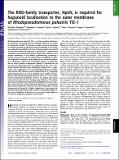| dc.contributor.author | Doughty, David M. | |
| dc.contributor.author | Coleman, Maureen L. | |
| dc.contributor.author | Hunter, Ryan C. | |
| dc.contributor.author | Sessions, Alex L. | |
| dc.contributor.author | Newman, Dianne K. | |
| dc.contributor.author | Summons, Roger E | |
| dc.date.accessioned | 2012-09-24T18:09:37Z | |
| dc.date.available | 2012-09-24T18:09:37Z | |
| dc.date.issued | 2011-08 | |
| dc.date.submitted | 2011-03 | |
| dc.identifier.issn | 0027-8424 | |
| dc.identifier.issn | 1091-6490 | |
| dc.identifier.uri | http://hdl.handle.net/1721.1/73126 | |
| dc.description.abstract | Rhodopseudomonas palustris TIE-1 is a Gram-negative bacterium that produces structurally diverse hopanoid lipids that are similar to eukaryotic steroids. Its genome encodes several homologues to proteins involved in eukaryotic steroid trafficking. In this study, we explored the possibility that two of these proteins are involved in intracellular hopanoid transport. R. palustris has a sophisticated membrane system comprising outer, cytoplasmic, and inner cytoplasmic membranes. It also divides asymmetrically, producing a mother and swarmer cell. We deleted genes encoding two putative hopanoid transporters that belong to the resistance–nodulation–cell division superfamily. Phenotypic analyses revealed that one of these putative transporters (HpnN) is essential for the movement of hopanoids from the cytoplasmic to the outer membrane, whereas the other (Rpal_4267) plays a minor role. C[subscript 30] hopanoids, such as diploptene, are evenly distributed between mother and swarmer cells, whereas hpnN is required for the C35 hopanoid, bacteriohopanetetrol, to remain localized to the mother cell type. Mutant cells lacking HpnN grow like the WT at 30 °C but slower at 38 °C. Following cell division at 38 °C, the ΔhpnN cells remain connected by their cell wall, forming long filaments. This phenotype may be attributed to hopanoid mislocalization because a double mutant deficient in both hopanoid biosynthesis and transport does not form filaments. However, the lack of hopanoids severely compromises cell growth at higher temperatures more generally. Because hopanoid mutants only manifest a strong phenotype under certain conditions, R. palustris is an attractive model organism in which to study their transport and function. | en_US |
| dc.description.sponsorship | National Science Foundation (U.S.). Division of Ocean Sciences (Chemical Oceanography Program) | en_US |
| dc.language.iso | en_US | |
| dc.publisher | National Academy of Sciences | en_US |
| dc.relation.isversionof | http://dx.doi.org/10.1073/pnas.1104209108 | en_US |
| dc.rights | Article is made available in accordance with the publisher's policy and may be subject to US copyright law. Please refer to the publisher's site for terms of use. | en_US |
| dc.source | PNAS | en_US |
| dc.title | The RND-family transporter, HpnN, is required for hopanoid localization to the outer membrane of Rhodopseudomonas palustris TIE-1 | en_US |
| dc.type | Article | en_US |
| dc.identifier.citation | Doughty, D. M. et al. “PNAS Plus: The RND-family Transporter, HpnN, Is Required for Hopanoid Localization to the Outer Membrane of Rhodopseudomonas Palustris TIE-1.” Proceedings of the National Academy of Sciences 108.45 (2011): E1045–E1051. ©2011 by the National Academy of Sciences | en_US |
| dc.contributor.department | Massachusetts Institute of Technology. Department of Earth, Atmospheric, and Planetary Sciences | en_US |
| dc.contributor.mitauthor | Summons, Roger Everett | |
| dc.relation.journal | Proceedings of the National Academy of Sciences | en_US |
| dc.eprint.version | Final published version | en_US |
| dc.type.uri | http://purl.org/eprint/type/JournalArticle | en_US |
| eprint.status | http://purl.org/eprint/status/PeerReviewed | en_US |
| dspace.orderedauthors | Doughty, D. M.; Coleman, M. L.; Hunter, R. C.; Sessions, A. L.; Summons, R. E.; Newman, D. K. | en |
| dc.identifier.orcid | https://orcid.org/0000-0002-7144-8537 | |
| mit.license | PUBLISHER_POLICY | en_US |
| mit.metadata.status | Complete | |
